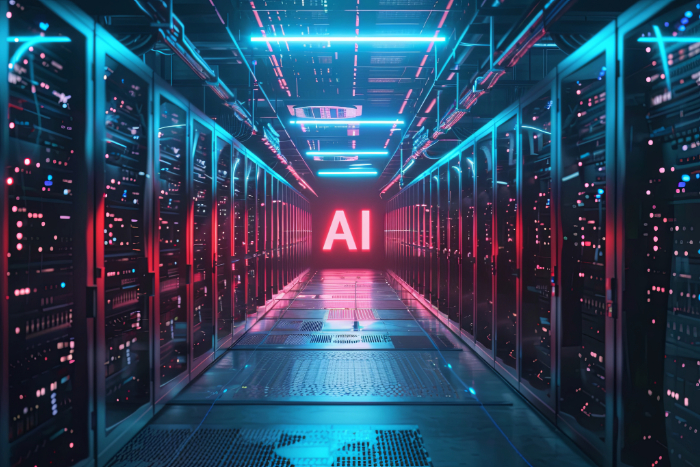
In the heart of Toronto, a groundbreaking initiative is transforming the way we think about data centers and sustainability. Enwave’s Deep Lake Water Cooling (DLWC) system harnesses the cold temperatures of Lake Ontario to cool hospitals, data centers, and commercial buildings. By drawing water from 83 meters below the lake’s surface, this system reduces electricity use by 75% compared to traditional air-conditioning methods, eliminating 40,000 tons of carbon dioxide annually—the equivalent of removing 8,000 cars from the roads.
This approach underscores the critical importance of developing sustainable, AI-ready data centers. As artificial intelligence (AI) continues to revolutionize industries, the demand for data processing and storage has surged, exacerbating the demand for expanding of data centers worldwide. However, this growth comes with significant environmental and infrastructural challenges.
Data center power consumption is projected to more than double over a mere 4 years, from 415 Terawatt-hours/year (TWh) in 2022 to an estimated 835TWh in 2026 — that’s the equivalent of adding the entire country of France to the power grid. Without a focus on sustainability, scaling out AI infrastructure will be unsustainable. Thankfully, data center developers and operators can utilize an array of tactics that promote sustainability, leverage edge computing, and modernize infrastructure to support AI workloads effectively.
The Importance of Sustainability and Green Data Centers
Traditional data centers often rely on energy-intensive cooling systems, contributing to higher operational costs and increased carbon emissions. The concept of green data centers focuses on minimizing these impacts through various innovations:
- Energy Efficiency: In the face of increasing power density in the processors, improvements to processor utilization and “work per watt” are paramount. Processors, storage devices, and networking components all increase performance per watt at each new generation. Additionally, industry leaders are re-inventing the server and processing architecture, breaking away from the central processing unit (CPU) architecture that dominated for decades to deploy domain-specific computing elements which are optimized for specific functions. “xPU” is the broad term to cover this increasingly diverse set of processors — Graphics Processing Units, LLM Processors, Edge Processors, Data Processors, Storage Processors, and so on.
- Moving away from moving air: Airflow has been the primary means of moving heat away from the processors and other server components. As individual processors have evolved from using 100-200W a decade ago to over 1200W for the latest GPUs, air cooling cannot keep up. Advanced cooling techniques, such as liquid cooling systems and full immersion cooling, offer efficient heat dissipation. The Aquasar supercomputer, for example, employs water cooling directly attached to processors, resulting in a 40% reduction in energy consumption compared to air-cooled systems.
- Renewable-Powered Data Centers: Utilizing renewable energy sources like wind and solar power is becoming increasingly viable. Microsoft’s data center expansion in the Nordic region leverages the area’s abundant carbon-neutral energy, aligning with the company’s goal to become carbon negative by 2030. There is no “silver bullet” for providing the power generation capacity data centers demand. Utilities and data center developers will need to leverage multiple technologies to meet the power generation need.
Edge Computing and Distributed Data Centers
As AI applications demand real-time data processing, the limitations of centralized data centers become evident, particularly concerning latency and bandwidth constraints. Edge computing addresses these issues by processing data closer to its source, reducing latency and enhancing the performance of AI applications. This decentralized infrastructure offers several advantages:
- Reduced Latency: By processing data locally, edge computing minimizes the delay in data transmission, which is crucial for applications like autonomous vehicles and real-time analytics.
- Bandwidth Optimization: Distributing data processing across multiple edge locations alleviates the burden on central networks, leading to more efficient bandwidth usage.
- Enhanced Reliability: Distributed data centers ensure that localized issues do not impact the entire network, thereby improving system resilience.
For instance, McDonald’s is overhauling its 43,000 restaurants to incorporate AI technologies, including AI-enabled drive-throughs and internet-connected kitchen equipment. By partnering with Google Cloud for edge computing, McDonald’s can process and analyze data on-site, leading to faster and more efficient operations.
Infrastructure Modernization and AI-Ready Data Centers
To effectively support AI workloads, businesses must modernize their existing data center infrastructures. This involves integrating advanced technologies that enhance performance, efficiency, and scalability:
- Solid-State Drive (SSD) Innovations: Incorporating write reduction technology and transparent data compression directly into SSD controllers can improve performance per watt and storage cost efficiency while boosting system-level efficiencies. These advancements are essential for handling the intensive data demands of AI applications.
- Compute Express Link (CXL) Technologies: CXL introduces a new means for attaching memory to the system – decoupling memory from the processors to enable more memory capacity and more memory bandwidth per core. This approach helps overcome the “memory wall,” a significant bottleneck in scaling AI workloads and optimizing GPU utilization. Implementing advanced Error-Correcting Code (ECC) in CXL modules increases reliability, availability and serviceability (RAS) to further enhance power efficiency.
- Modular Data Centers: Deploying modular data centers allows for rapid scalability and energy efficiency. These portable units can be strategically placed to meet immediate data capacity needs, supporting the dynamic requirements of AI workloads.
The NCAR-Wyoming Supercomputing Center (NWSC) exemplifies infrastructure modernization with sustainability in mind. The facility uses Wyoming’s climate to provide natural cooling during 96% of the year and local wind energy that supplies at least 10% of its power. These features make it 89% more efficient than a typical data center.
As the demand for AI capabilities continues to grow, the imperative to develop sustainable, efficient, and AI-ready data centers becomes increasingly critical. By embracing energy-efficient technologies, leveraging edge computing, and modernizing infrastructures, businesses can meet the computational demands of AI while minimizing environmental impact. Innovations such as Enwave’s DLWC system and Microsoft’s renewable energy initiatives serve as exemplary models for integrating sustainability into data center operations. Through these strategies, organizations can ensure that their data centers are not only prepared for the future of AI but also contribute positively to global sustainability efforts.




